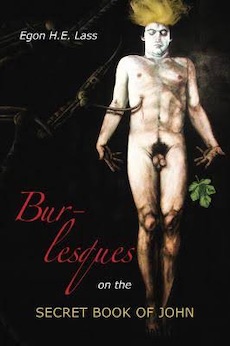By Louis J. Kern
Egon H.E. Lass, civil rights activist, archeologist, and poet, provides a revisionist interpretation of human origins closely based on the second-century Gnostic text the Apocryphon of John, a heterodox, pre-canonical explication of developmental mythology.
In the Apocryphon the first revelation of the transcendent God is the creation of the Perfect Man—Pigera or Adamas. Subsequently, the arrogant ruler of the nether world, Yaldabaoth, says to his “authorities,” “let us create a man according to the likeness of the first Perfect Man.” Employing the four primary elements and using their unique individual skills, they set about the somatic construction of the human prototype. Their task completed, Yaldabaoth blows his breath into the body and quickens it.
Lass’ sardonic reconceptualization of the origins of humanity is a free verse mock-epic. It details the work of 74 angels, each assigned a particular aspect of the project. Its sensibility is clearly shaped by Shelly’s Frankenstein (vividly delineated by the cover illustration) and a Bakhtinian construction of Rabelais’ The Life of Gargantua and Pantagruel emphasizing the carnavalesque and grotesque realism. Adam’s construction, for Lass, is the work of a competitive, bickering, resentful, and jealous corps of workers, employing often ill-assorted, inferior materials in the absence of a coherent master-plan or systematic procedural instructions. At times the assembly line of production breaks down as differing agendas result in fabrication errors that bring to mind the factory breakdown in Chaplin’s Modern Times (1936). As Lass observes, perhaps “the ‘expert’ angels were too layered”; “Were there forces underway / Trying to sabotage this very Adam, / This supposed paragon of all human bodies following”?
The work is designated a “burlesque,” a comic imitation of a serious artistic form—in this case the biblical creation story and the heroic epic poem. It operates in the narrative space between its serious subject matter and frivolity, providing an often broad and coarse parody that lends an aura of triviality to its subject. The burlesque owes much to its Italian satiric form burlesco that made use of ridicule, mockery, and comedy to provide an alternative perspective often critical of established norms. In American popular culture, the burlesque show combined comedic vaudeville skits that lampooned current events, ribald skits, and tantalizing striptease acts.
Burlesques manifests all this, especially the striptease, since it details the piecework construction of the male body from the head to the buttocks, penis and testicles, and ends with the toenails. Questioning orthodox dogma on creation, Lass employs scientific references (the “naked Vacanti” that grew a human ear on its back in 1997), contrasting with slapstick (at the sound of the word “draw” a man reaches for his gun, his finger sticks in his belt “Thus loosening the britches, / Falling down around the ankles”). References to popular culture abound: Marvel comics’ Dr. Octopus (Otto Octavius), enemy of Spiderman; “the Thrilla in Manilla”; and a bemused “What is so secret about Victoria?” There are ample references to Greek myth and a critique of current fads and practices: “manspreading,” underarm hair dying, and botox. A serious critique of the atrocities of modern history—concentration camps, 9/11, terrorists, the a-bomb, and ecological peril—underlies Lass’ savage pessimism about the human condition. “Welcome to the Pyrocene,” he announces: “We are building what will be / The most destructive creature / Ever assembled by our natural causes. / . . . A mass-murderer and cannibal, not just / Of strangers, but of his own family. And that, my friends / Is what you are helping to create. Welcome to reality! / Let’s paste and powder and grow and glue / This lousy son of a bitch!” From Lass a final derisive guffaw for the universal pilgarlic that is “human, all too human.”
Louis J. Kern (ΦBK, Clark University,1965) is professor emeritus of history at Hofstra University. Hofstra University is home to the Omega of New York chapter of Phi Beta Kappa.




